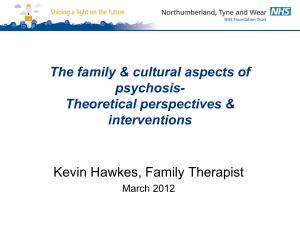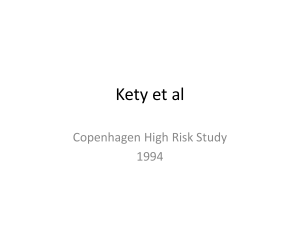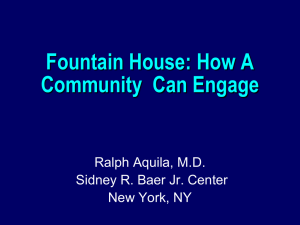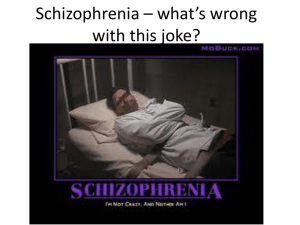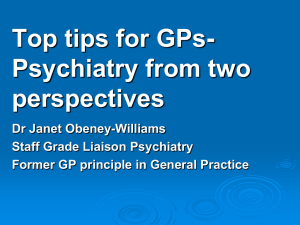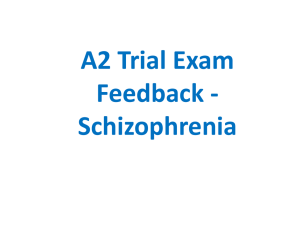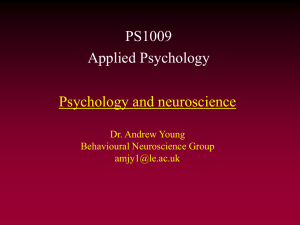the PowerPoint - Arkansas Psychiatric Society
advertisement
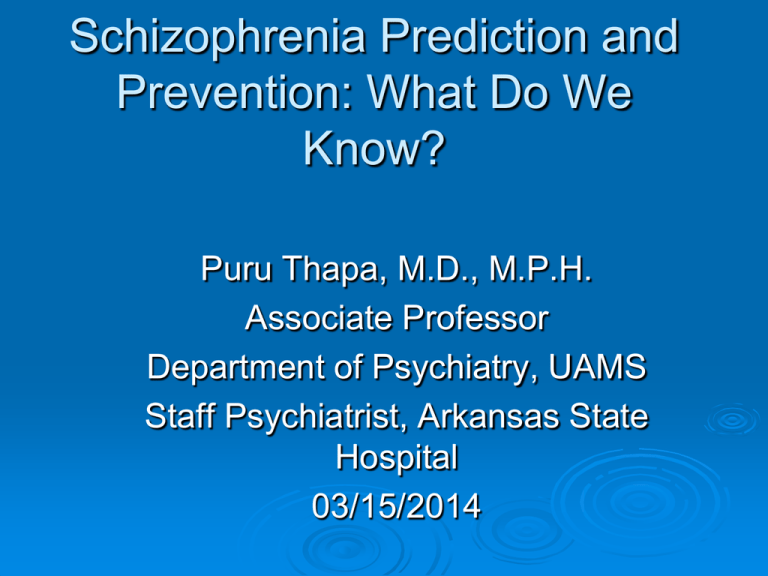
Schizophrenia Prediction and Prevention: What Do We Know? Puru Thapa, M.D., M.P.H. Associate Professor Department of Psychiatry, UAMS Staff Psychiatrist, Arkansas State Hospital 03/15/2014 Objectives Review definition, epidemiology and etiology of schizophrenia Understand the concept of levels of preventions Critically review the strategies of prevention in schizophrenia and evidence Consider future directions Schizophrenia Syndrome characterized by psychosis and dysfunction and probably the most devastating mental illness with great distress to the individual and families with heavy costs and burden to society Treated with antipsychotics and psychosocial support and rehab Schizophrenia – DSM-5 Criteria A. Two (or more) of the following, each present for a significant portion of time during a 1-month period (or less if successfully treated). At least one of these must be (1), (2), or (3): 1: 2: 3: 4: 5: B. Delusions Hallucinations Disorganized speech Disorganized or catatonic behavior Negative symptoms Social/occupational dysfunction Schizophrenia – DSM-5 Criteria C. Duration: continuous signs persist for at least six months D. Exclude schizoaffective or mood disorder E. Exclude general medical condition or substance induced F. Relationship to a pervasive developmental disorder Schizophrenia - Costs Cost of Schizophrenia in the US in 2002 Direct Costs 30.3 billion dollars Indirect Costs 32.4 billion dollars Total Costs 62.7 billion dollars Mental anguish/distress to individuals affected and to families Wu EQ and colleagues, J Clin Psych 2005;66:1122-1129 Schizophrenia - Epidemiology Life time prevalence approximately 1% Incidence estimated .01% to .02% Risk slightly higher in males than females Age of onset: males 15-25 years, females 25-35 years Phases of Schizophrenia Premorbid Prodromal Contributes to vulnerability to schizophrenia Change from premorbid functioning and extends time of onset of frank psychotic symptoms Average length 2 – 5 years Impairment in psychosocial functioning Psychotic Onset of frank psychotic symptoms Acute phase, Early recovery phase (first 6 months after acute treatment), Late recovery phase (6-18 months) Period following recovery from first episode up to 5 years is Critical Period for up to 80% relapse Prodrome Early prodromal symptoms non-specific: sleep disturbance, anxiety, irritability, depressed mood, poor concentration and fatigue, and behavioral symptoms, such as deterioration in role functioning and social withdrawal Late prodromal symptoms: positive symptoms, such as perceptual abnormalities, ideas of reference, and suspiciousness – herald imminent onset of psychosis Prodrome – really based on retrospective reconstruction Schizophrenia - Etiology Etiology unknown – can be conceptualized as a clinical syndrome that is the “final common pathway of multiple different etio-pathogenetic processes”. Similar to concept of Congestive Heart Failure or Nephrotic Syndrome Neurodevelopmental – factors during perinatal period, genetics Neurodegenerative Other factors: season of birth, paternal age, diet during pregnancy, obstetrical complications, etc. Stress-Diathesis Model of disease causation Stress-Diathesis Model Diathesis: Inherited vulnerability – bad genes Stress: Environmental insult – physical, emotional, environmental This model offers our best explanation of schizophrenia cause Genes/Environment • Genetic predisposition – – – – • 1 parent with schizophrenia Both parents Dizygotic twin of schizophrenia patient Monozygotic twin 12% 40% 12% 47% Environmental – – Intrauterine trauma? (physical, drugs, etc) Later trauma or stress? Often the 1st psychotic break happens during a stressful period such as going away to college, military, etc. Challenges in Prevention of Schizophrenia • Disorder with unclear etiology • No objective marker or test to diagnosis • Rare disease • Antecedent factors and prodromal symptoms are not specific – high number of false positives Predictive Value Gold Standard Test Results Positive Negative With Disease Without Disease True Positive (TP) False Positive (FP) a b c d False Negative (FN) True Negative (TN) PPV = TP/(TP+FP) or a/(a+b) = 80/(80+100) = 44% NPV = TN/(FN+TN) or d/(c+d) = 800/(800+20) = 98% Epidemiology and Prevention To identify high-risk subgroups in population Why? Identification of high risk groups may identify modifiable risk factors. Can direct preventive efforts at such groups – such as screening programs for early detection of disease Levels of Prevention 1. Primary Prevention of disease by altering susceptibility or reducing exposure for susceptible individuals e.g., immunization, exercise 2. Secondary Early detection and treatment of disease e.g., breast cancer screening, screening for disease (occult blood in stool for colon cancer) 3. Tertiary Limitation of disability and rehabilitation Alleviation of disability resulting from disease and attempts to restore function (Post-stroke rehabilitation) Prevention – can be population-based or high risk group approach Primary Prevention of Schizophrenia Limited understanding about etiology and pathogenesis of schizophrenia Long latency between primary insult and onset of schizophrenia Much research ongoing but not currently feasible Tertiary Prevention Tertiary prevention – reducing the burden of disease by optimizing treatment and rehabilitation and reducing relapse In Schizophrenia, with tertiary prevention if remission rates increase, then prevalence may fall with lower burden Very important to address but disease has already manifest Secondary Prevention Secondary prevention - modify course of illness by early detection, intervention and possibly prevention Potentially feasible through intervention at the prodromal phase Aim is to reduce full transition from prodromal to schizophrenia Interventions could Delay onset of illness Mitigate profile of illness to “milder” or “less disabling” Hope is to reduce cost and burden of disease How Do We Define the Population to Target for Secondary Prevention? Genetically Vulnerable Population Research has focused on genetically vulnerable individuals Unable to identify which individuals within genetic high-risk group will eventually develop schizophrenia with sufficient predictive value to justify intervention Problem with this approach is that of low sensitivity since nearly 80% of affected individuals with schizophrenia have no 1st degree relatives and nearly 60% have negative family history Factors Predicting Schizophrenia Spectrum Outcomes in Offsprings of Schizophrenia Patients Maternal influenza during gestation Obstetrical complications Neurointegrative deficits in infancy Separation during first year of life Social, affective, and motor coordination deficits in early childhood Social dysfunction in later childhood Attention deficits, neuribehavioral deficits and poor motor coordination in preadolescence Teacher rated timidity and day dreaming behaviors at age 15 years Absence of protective family environment Prodromal Phase Focus of Intervention Why Intervention in Prodromal Phase? 1. 2. Neurobiological deficit processes associated with severity and chronicity with schizophrenia are already present at time of first episode Evidence suggests early treatment can result in significant reduction in morbidity and better quality of life DUP – Duration of untreated psychosis is defined as time between onset of first psychotic symptoms and first adequate treatment Average DUP is 1 – 2 years Longer DUP associated with male gender, poor premorbid functioning, insidious onset of psychosis, and presence of negative symptoms A review of 25 DUP studies showed two thirds of them had better outcome on one or more measures for shorter DUP and none showed better outcomes with longer DUP Why Intervention in Prodromal Phase? 3 Treatment in prodrome may prevent or delay onset 4 Important to treatment prodromal symptoms themselves to relieve distress for parents and families Specialized Early Intervention Programs PACE – Personal Assessment and Crisis Evaluation clinic, Melbourne, Australia RAP – Hillside Recognition and Prevention Program, NY EDIE – Early Detection and Intervention Evaluation Program, Manchester, UK PRIME – Prevention through Risk Identification, Management, and Education Program, Yale Univ, CT CARE – Cognitive Assessment and Risk Evaluation Clinic in San Diego, CA Prevention Strategies Psychopharmacology Cognitive/Cognitive Case Management Behavior Therapy McGorry et al. Arch Gen Psychiatry. 2002;59:921-928 Design: Single blind (researchers) randomized controlled trial comparing two treatments in 59 patients (age 14-30 years) at “ultra-high risk” Interventions: Needs Based (focus on needs based supportive therapy re social, family issues, case management) vs Specific Preventive (Needs Based and low dose risperidone and cognitive behavior therapy) Outcome: progression to frank psychosis lasting a week or more Treatment duration 6 months. After this all patients were offered Needs Based Intervention. Assessment at baseline, 6 months, 12 months Note: 43 of 59 (73%) did not progress to psychosis at 12 months McGorry et al. Arch Gen Psychiatry. 2002;59:921-928 Number Needed to Treat (NNT) = 4. (NNT = 13 for antihypertensives to prevent stroke) In other words, 4 ultra-high risk patients would need to be treated to prevent 1 patient from progressing to psychosis over a 6 month period Conclusions: Specific pharmacotherapy and psychotherapy reduces risk of early transition to psychosis in these patients but unclear which modality more contributory Ethical dilemma: 73% did not transition to psychosis. Is using AP justified? Potential Benefits of Prepsychotic Interventions. McGorry et al. Arch Gen Psychiatry. 2002;59:921-928 Patients more easily engaged and can receive treatments regardless of whether preventive treatment may be ineffective or unnecessary Those who progress to psychosis have developed a level of trust enabling them to accept treatment, have minimal DUP and reduced comorbidity Psychosocial impact of psychosis may be diminished and better chance to recover McGlashan et al. Am J Psychiatry. 2006;163:790-799 Design: Double blind randomized controlled trial comparing two treatments in 59 patients (age 14-30 years) at “ultra-high risk” Interventions: Olanzapine (Dose 5-15 mg/d) N=31 Placebo N=29 Outcome: progression to frank psychosis Treatment duration 1 year; a second year of follow-up with no treatment At one year, 16.1% of olanzapine and 37.9% of placebo converted to psychosis (p=.08). Olanzapine group had more improvement in symptoms. At two years, most were lost to follow-up; but of remaining no difference McGlashan et al. Am J Psychiatry. 2006;163:790-799 Treatment difference not significant Olanzapine group had improvement in symptoms Major side effect of olanzapine – GUESS? Authors admit study had low power - they tried to recruit more subjects but were not successful Cornblatt et al. J Clin Psychiatry. 2007;68(4):546-557 Design: Prospective naturalistic treatment study of adolescents (mean age 15.8 years) considered to be “prodromal” (i.e., prepsychotic) Interventions: Antidepressants (N=20) Second generation antipsychotics (N=28) Outcome: progression to frank psychosis defined as a score of 6 in any 1 of 5 positive symptom scale of the SOPS (Scale of Prodromal Symptoms) lasting 2 weeks or more Treatment duration at least 6 months (mean duration 30.5 months). Recognition and Prevention Program (RAP), Zucker Hillside Hospital, NY Cornblatt et al. J Clin Psychiatry. 2007;68(4):546-557 Results: 12 of 48 subjects (25%) converted to psychosis 0 from the AD group (N=20) 12 (43%) from the AP group (N=28) BUT, 11 of 12 converters were non-adherent to the AP Cornblatt et al. J Clin Psychiatry. 2007;68(4):546-557 Non-random assignment limits comparison of AD with AP But number of adolescents with prodromal features did well on AD True prevention or False Positive? Underscores retrospective nature of prodrome and challenge in prevention. Van Os J, Delespaul P. Toward a world consensus on prevention of schizophrenia. Dialogues in Clinical Neuroscience. 2005; 7:53-67. Challenges Unclear understanding of disease and lack of better early identification of high risk individuals with lower false positives. Promising research describing better endophenotypes. Stigma – especially relevant because of high degree of false positives Lack of resources Conclusions Primary prevention of schizophrenia continues to be elusive because of our inadequate understanding of etiology resulting in high degree of false positives Selective intervention shows promise but use of pharmacotherapy for prevention still not established Have to consider issues of stigma and public awareness and education Lack of resources for preventive activity Bibliography Brown AS, McGrath JJ. The Prevention of Schizophrenia. Schizophrenia Bulletin. 2011; 37(2):257-261. Brown AS, Patterson PH. Maternal Infection and Schizophrenia: Implications for Prevention. Schizophrenia Bulletin. 2011; 37(2):284290. Cornblatt BA, Lencz T, Smith CW et al. Can antidepressants be used to treat the schizophrenia prodrome? Results of a prospective, naturalistic treatment study of adolescents. Journal of Clinical Psychiatry. 2007; 68:546-557. Cornblatt BA, Auther AM. Treating early Psychosis: who, what, and when? Dialogues in Clinical Neuroscience. 2005; 7(1):39-49 Kirkbridge JB, Jones PB. The Prevention of Schizophrenia- What Can We Learn From Eco-Epidemiology? Schizophrenia Bulletin. 2011; 37(2):262-271. Knapp M, Mangalore R, Simon J. The global costs of schizophrenia. Schizophrenia Bulletin. 2004: 30(2):279-293. Bibliography Lee C, McGlashan TH, Woods SW. Prevention of Schizophrenia: Can it be achieved? CNS Drugs. 2005; 19(3):193-206. McEvoy JP. The costs of schizophrenia. Journal of Clinical Psychiatry, 2007; 68 (suppl 14): 4-7. McGlashan TH, Zipursky RB, Perkins D et al. Randomized, doubleblind trial of olanzapine versus placebo in patients prodromally symptomatic for psychosis. American Journal of Psychiatry. 2006; 163:790-799. McGorry PD, Killackey E, Yung AR. Early intervention in psychotic disorders: detection and treatment of the first episode and the critical early stages. The Medical Journal of Australia. 2007; 187(7 suppl):S8-S10. McGorry PD, Yung AR, Phillips LJ et al. Randomized controlled trial of interventions designed to reduce the risk of progression to first episode psychosis in a clinical sample with subthreshold symptoms. Archives of General Psychiatry. 2002; 59:921-928. Bibliography Tsuang MT, Stone WS, Auster TL. Prevention of schizophrenia. Expert review of Neurotherapeutics. 2010; 10(7):1165-1174. Van Os J, Delespaul P. Toward a world consensus on prevention of schizophrenia. Dialogues in Clinical Neuroscience. 2005; 7:53-67. Wu EQ, Birnbaum HG, Shi L et al. The economic burden of schizophrenia in the United States in 2002. Journal of Clinical Psychiatry. 2005; 66:1122-1129. McGrath JJ, Brown AS, St Clair D. Prevention and Schizophrenia-- The Role of Dietary Factors. Schizophrenia Bulletin. 2011; 37(2):272-283. Yung AR, Killackey E, Hetrick SE et al. The prevention of schizophrenia. International Review of Psychiatry. 2007; 19(6): 633646. Yung AR, McGorry PD, Francey SM et al. PACE: a specialized service for young people at risk of psychotic disorders. The Medical Journal of Australia. 2007; 187(7 suppl): S43-S46.

